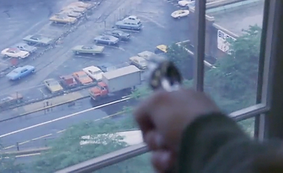Katie Zombo
Techniques of Perspective

This assignment was to create a presentation in order to explain the concepts described in the book Setting Up Your Shots.
My group's assigned chapter was "Techniques of Perspective," which described different techniques used in film-making in order to create certain effects.
-
Reflection
-
Portal
-
Point of View
-
Inventory POV
-
POV Object/POV Projectile
-
Voyeur
-
Dark Voyeur
-
Shadow
-
Silhouette
-
Tension Away
The world is seen through a reflected image rather than the world as it really is.
We are forced to see a reality that has been briefly distorted.
Reflection

Example from Jurassic Park. The dinosaur is reflected through the side view mirror.
Portal
A portal is a way of looking at reality as it is filtered through some kind of device.
For example, a character watching a television set.

Example from The Truman Show. The people in the movie are watching television.
Point of View
The audience sees exactly what a character in a film sees.
POV can be used to increase the audience's emotional attachment to the characters.

Example from Jaws. The point of view is from the shark looking up at the swimmers.
Inventory POV
A variation on the standard POV technique.
The character carries an object in front of his face. This object shows up in the frame and allows the audience to see what he is holding in his hands.

Example from Taxi Driver. The point of view is from the character, but the only thing in the frame is the gun in his hand.
POV Object/Projectile
POV Object takes the perspective of an inanimate object.
POV Projectile follows a projectile to its destination. It allows the audience to "experience" the projectile.

Example from Robin Hood: Prince of Thieves. The camera follows the path of the arrow that was shot.
Voyeur
Spying on the private and intimate lives of the characters onscreen.
A shot may be framed in such a way (through binoculars, from inside a closet) that emphasizes the voyeuristic aspect.

Example from Disturbia. The character does not want to be seen as he spies on his neighbor committing a malicious act.
Dark Voyeur
The classic horror and psychological thriller gimmick.
Used to evoke feelings of the characters in a film being watched, usually by someone or something with malicious intent.

Example from Silence of the Lambs. In this case, the "object" the malicious person is hiding behind is darkness.
Shadow
A unique representation of reality that can help a filmmaker show a scene's action indirectly.
Useful when it is difficult or undesirable to show what is actaully taking place in a scene (inappropriate, vulgar, scary).

Example from Psycho. This shower scene uses shadow and is not clearly portrayed in order to make it less disturbing and violent.
Silhouette
Created by placing film characters against very strong backlighting so that the character's features and expressions become darkened or even completely black.
Contrast a character to its surroundings.

Example from The Lion King. The details and expressions of the animals running are not clear because of the use of silhouette.
Tension Away
Actors engage in entire conversations without actually looking at one another.
Can create feelings or isolation or loneliness. Might indicate hidden feelings or grudges.

Example from Ocean's 12. Brad Pitt and George Clooney do not look at eachother during their exchange in this scene.
Tension to Camera
The actor looks directly into the camera.
Can be used to make the audience uneasy or nervous. Can also be used to draw attention to a specific shot or setup.

Example from Alice in Wonderland. The Cheshire Cat looks directly into the camera to emphasize the unsettling, uncomfortable nature of the character.
Broken Wall
The actor speaks directly at the camera.
When the imaginary "fourth wall" is broken, the realities of the story and the audience are intertwined.

Example from Ferris Bueller's Day Off. Ferris breaks from his own reality and speaks directly to the audience as if they were there.
Mask/Vignette
A Mask is an area of the screen that is blacked out as if our field of vision was reduced.
A Vignette is similar to a Mask but it can have some shape or form.


Example from Rear Window. The camera lens frames the subject with blackness.
Example from opening sequence of James Bond. The barrel of the gun frames the subject.
Screen
Objects that act as filters for a scene.
Useful tools to set the mood of a scene.
Can be used to give insight into a character's mood or feelings. Can show great emotion with a narrowed view.

Example from The Hunger. The chaos and turmoil of the prisoner's adjusting to their new prison life is viewed through small slits in the prison door.
Subjective
Involves strapping a camera to an actor's body so that when the actor moves, the camera moves with him.
The camera becomes a part of the character's subjective experience.

Example from Despicable Me. The character is on a roller coaster, and the audience experiences riding the roller coaster because of the subjective camera perspective.
Click on the movie titles to see a clip showing each technique.
-
Tension to Camera
-
Broken Wall
-
Mask/Vignette
-
Screen
-
Subjective